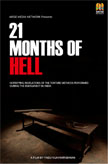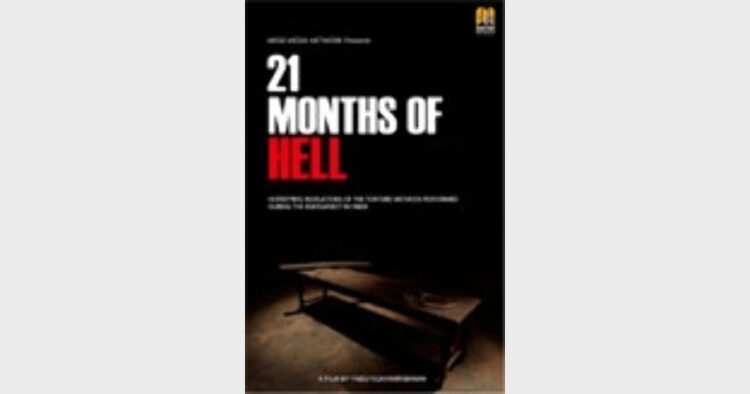 The 70-minute film, 21 Months of Hell depicts the struggle of Swayamsevaks in Kerala that hitherto left unrecorded and unrecognised either by political scientists or the successive governments
The 70-minute film, 21 Months of Hell depicts the struggle of Swayamsevaks in Kerala that hitherto left unrecorded and unrecognised either by political scientists or the successive governments
Ganesh Krishnan R
After 42 years, the wounds of gory days of Emergency might have healed, but the scars it left on Indian minds still remain. The period of 21 months (1975-1977) was the most critical and testing time for Indian democracy ever since the country was liberated from British rule. It also exposed the hitherto unknown Fascist face of Congress Party which brutally oppressed the citizens using all means of power. The brutal atrocities unleashed on the political opponents of Indira Gandhi were unequalled in many ways. Many individuals, organisations and institutions who struggled against the state-sponsored terror to reinstate the Constitutional Rights.
“RSS was the only democratic force which fought against Emergency”After the first preview of ’21 Months of Hell’ in New Delhi, the documentary received much critical acclamations from different quarters. The 24-year-old director Yadhu Vijayakrishnan spoke to Organiser about his documentary. Excerpts: |
The freedom of the press was curbed and journalists were put behind the bars. With suspending the Constitution, the iron fist of the Indira regime crushed the civil liberties chalked many media organisations to an untimely death. The Motherland edited by KR Malkani, former editor of Organiser, was one of the first victims of Emergency. With an exception of a few newspapers like The Motherland and The Indian Express, the print media surrendered to the Fascist regime and churned out pro-Emergency reports, that too after obtaining approval from the Censorship Committee. All across the country, the Congress workers parroted the slogans like “India is Indira, Indira is India”. The spineless media echoed it. As LK Advani rightly said, “You (journalists) were asked to bend but you crawled.”
While the tragic history of Indian democracy has been well-recorded elsewhere in the country, Kerala was an aberration. In fact, the democrats in Kerala were the most unfortunate and hapless victims. During Emergency, Kerala was ruled by CPI-Congress coalition, which proved to be a deadly cocktail in those days. K Karunakaran, a close aide of Indira Gandhi was the Home Minister then while CPI leader C Achutha Menon ruled the state as Chief Minister. Taking it as an opportunity, K Karunakaran and Congress unleashed the rabid police force on RSS Swayamsevaks in Kerala.
Gory Days
The film begins with a narration of former Jana Sangh and BJP leader K Raman Pillai who was instrumental in the anti-Emergency movement in Kerala under the banner of Lok Sangharsh Samiti led by Jayaprakash Narayan. Sharing his experience on screen, he gives an outstanding account of the struggle of Rashtriya Swayamsevak Sangh and other associated nationalist organisations like ABVP, Jana Sangh etc. In between, the director takes you to the gory days of Emergency, with a focus on the violent oppression of the state machinery and brutal torturing methods which Swayamsevaks underwent those days. He also remembers the treacherous role of Communist Parties played in Emergency. While CPI was in the power and sided with the Congress, CPM consciously kept away from the agitation as a part of the strategy as they knew it was not the CPM but RSS was the prime target of Indira Gandhi.
The film throws light on the exclusive and ingenious torture techniques and devices administered by Kerala Police to silence the protests against the Indira regime. The real-life narrations of the surviving victims give more clarity to the visual recreation of the days of Emergency and make it an unforgettable visual experience. Though the film is in Malayalam, English subtitles enable the non-Malayali audience to understand the narration and dialogues.
Gruesome Torture
The documentary features the cruellest of cruel torture methods which were meted out on the prisoners under illegal police custody. The ghastly scenes are followed by the narration of real victims who were subjected to the brutal torment. Among those who suffered the sheer mental and physical agony, one name stands out, Shri Vaikom Gopakumar– a living martyr of?Emergency. Leaving the audience horror-struck and aghast, his bone-chilling narration gives a clear picture of the atmosphere of terror prevailing in Kerala those days that virtually transformed the God’s own country into a hell. Many lost their lives and many more rendered bed-ridden. As featured in the film, most of the victims of MISA (Maintenance of Internal Security Act) who suffered the agony and torments were students.
Apart from a mere recreation of Emergency days, the film seeks various approaches to bring out the reasons and consequences of sadistic treatment of prisoners. The expert opinions, especially those of a forensic surgeon on immediate and long-term medical effects of various torture methods, give more authenticity and clarity to the versions of victims. With a limited period of time and a frugal budget, the 24-year-old director Yadhu Vijayakrishnan did quite an impressive work which deserves rounds of applauds. He materialised his work with the support of the Arise Media Network, a novel initiative by a social media fraternity. Arise has been formed with a view of promoting nationalist narrative and ideas in the realm of art and media.
Exhibited in the presence of Emergency victims, the documentary took the viewers back to the dark and horrific days of Emergency they lived through. Ashwini Kumar Choubey, the Minister of State for Health and Family Welfare, was the chief guest in the ceremony which has been organised under the aegis of Forum for Social and Cultural Resurgence at Films Division Auditorium, New Delhi. Shri Ashwini Choube shared his reflections on the film and his memories, being a part of JP Movement in Bihar. Among the other speakers were Manoj Tiwari, the President Delhi state unit of BJP, Smt Shilpa Nair, the director of Arise Media Network and Yadhu Vijayakrishnan, the director of the film.
The sun set on India on June 25, 1975. Indians had to wait until March 21, 1977, to see the ray of the sun and breathe the air of freedom. By that time, the mother India had lost many of her children who dared the Fascist Indira regime. The 70 minute-long film well-documented the struggles of nationalists, Swayamsevaks in Kerala that were left unrecorded and unrecognised either by political scientists or the successive governments. n













Comments